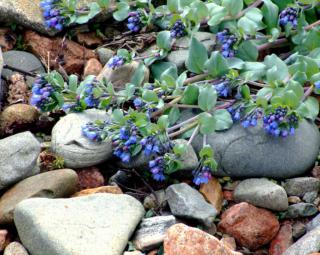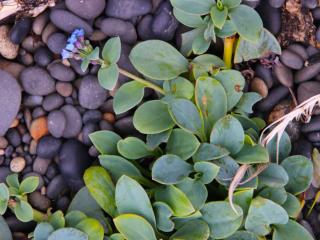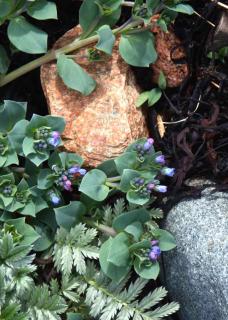

Mertensia maritima, also called oyster plant or oysterleaf, is a surprising herb.
Name – Mertensia maritima
Family – Boraginaceae
Foliage – evergreen
Type – herbs and spices, perennial
Height – 1 ½ feet (15 cm)
Exposure: part sun – Soil: well-drained – Flowering: summer
The oyster plant has a quite uncanny taste for a member of the plant kingdom.
Sowing the plant from seed is certainly the best way to grow mertensia.
That way, you’ll encourage the oyster plant to settle into its growing environment, and will ensure it develops well.
This plant, which is quite fragile, doesn’t much like being moved around or transplanted.
It’s also possible to prepare seedlings in a sheltered spot a bit earlier, and then carefully transplant to the ground in spring.
If you were able to prepare seedlings in a covered spot, or if you’ve purchased your plants in a store, it’s best to wait for spring to transplant your mertensia.

The oyster plant is rather fragile, and you’ll have to pay attention to its needs if you hope to see it grow to the point of harvesting its delicious herb leaves.
 Cut the stems back to half their length regularly, this gives the plant vigor and will fortify it.
Cut the stems back to half their length regularly, this gives the plant vigor and will fortify it.It’s also a good idea to mulch the base of the plant in summer, this helps keep the ground cool.
The leaves can be harvested when needed from spring to fall.
These 2 parasites, snails and slugs, are the 2 most devastating pests for Mertensia maritima.
Indeed, they simply crave its leaves when they can access them, and will mow down an entire plant in days.
It’s preferable to protect your Mertensia maritima from snails and slugs with a protective net or mulch prepared from sharp, dry needle-like material.

It’s delicious both raw and cooked.
Mertensia maritima was and is known under different names. The most common name is “oyster plant”, but it’s also called “oyster leaf”, sea mertensia, and sea bluebells.
Virginia lungwort is a cousin variety, Mertensia virginica.
Offer your guests a mertensia leaf when you pass around glasses of Champagne: they’ll be amazed and impressed with this surprising yet delicious pairing!
(Only drink alcohol in moderate amounts…)
I have a very large pot for my oyster leaf. I mixed Perlite with potting soil; I potted my plant. It seemed to do so-so sitting in an eastern window. Sadly, the leaves slipped away one by one. So, are the roots dead?? How much sun does the plant want and need? I love these leaves!! I have a thermometer in the dirt to make sure the plant doesn’t get overheated. What else can I do??
Do you sell Mertensia maritima seeds? I would like some, if so.
Hi Jana, no, we don’t sell any seeds. Try to look for it on an online store, because not many nurseries are going to have them. Or, better yet, call up your local nursery and see if they can order/get some; that way, you’ll build up a local relationship and they might also like discovering a new plant for their other customers!